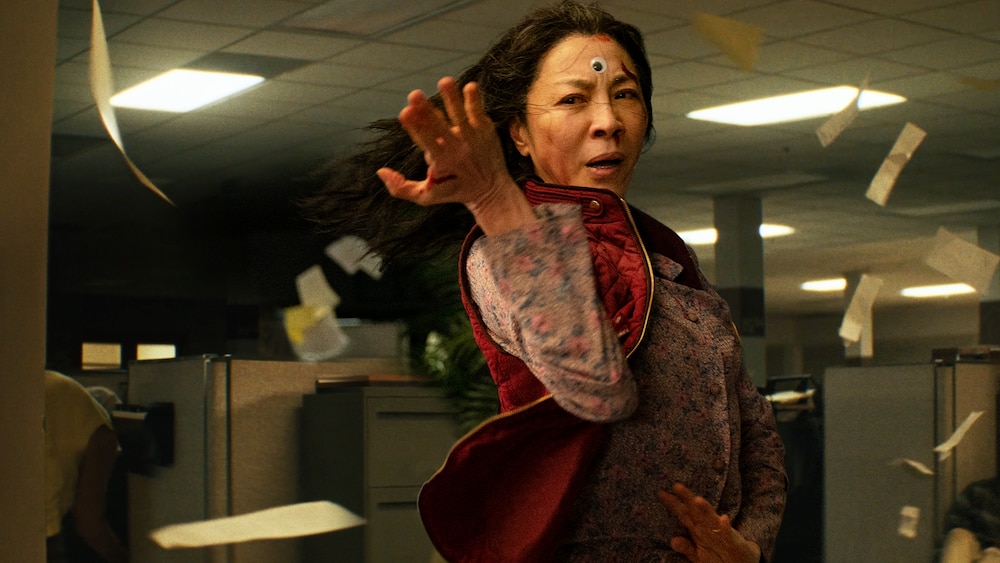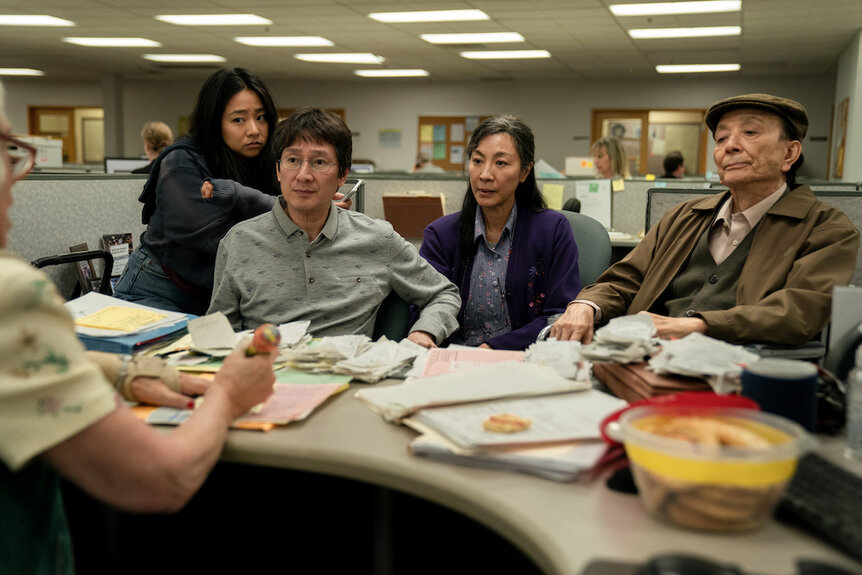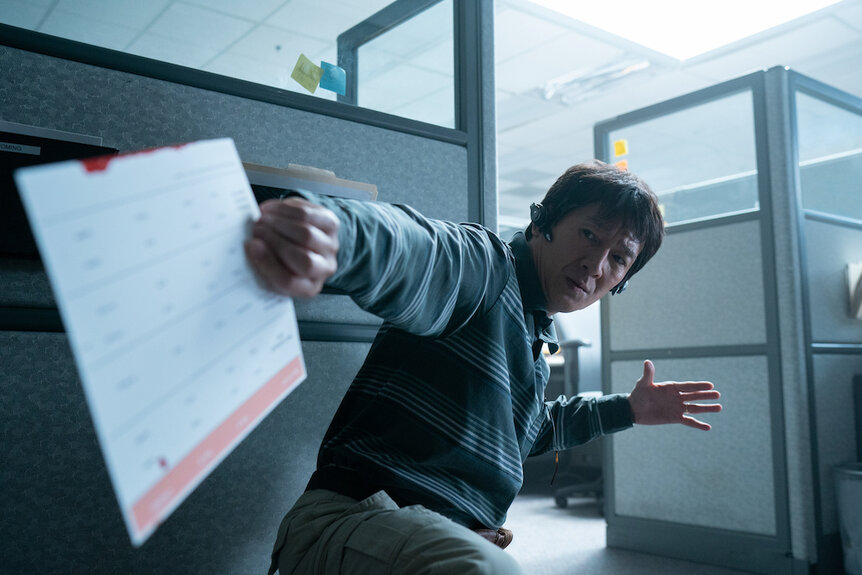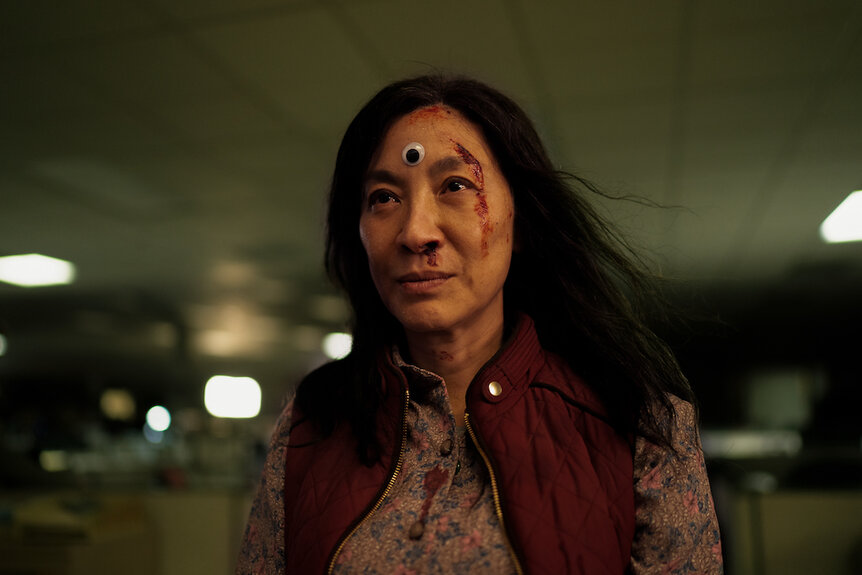Create a free profile to get unlimited access to exclusive videos, sweepstakes, and more!
'Everything Everywhere All at Once' directors on avoiding platitudes and hot dog-finger biology
The director duo Daniels unpack their ambitious, genre-defining film and explain where the ketchup and mustard really comes from.

The multiversal masterpiece Everything Everywhere All at Once has enjoyed almost unanimously glowing reviews and word-of-mouth since it premiered in late March, to the point where the movie is now the No. 1 title on Letterboxd, a movie-cataloging social media site favorited by film buffs. If you’re at familiar with how things tend to go online, however, you know that whenever something is this beloved and popular, a backlash is sure to follow.
But Daniels — the director duo of Dan Kwan and Daniel Scheinert — say the harshest criticisms they’ve received for the film have come from a perhaps unexpected source.
“So far, the people who like it the least are the parents of our cast and crew, because it reflects on them, you know? ‘My kid worked on this and it confuses me!’” Scheinert tells SYFY WIRE. The film, which stars Michelle Yeoh as a laundromat owner who is literally living her worst life (in her corner of the multiverse), builds to a grand, crazy emotional climax when she and her daughter (Stephanie Hsu) must reconcile their relationship and make sense of it all — literally it all.
“It’s an ongoing conversation with our parents and their parents, and it’s almost like the movie is acting itself out as these generations try to communicate with each other, and that’s exciting,” Scheinert continues. “I think we’re, within reason, interested in the backlash. We want to know what people are feeling and why, and what didn’t hit home and why. Hopefully, we don’t take it so personally that then we’re afraid to take risks in the future because those risks really paid off for some folks.”
Whatever backlash may or may not lurk on the horizon, there’s plenty to celebrate in Everything Everywhere All at Once and a lot to talk about. SYFY WIRE chatted with the Daniels about making a movie that’s both zany and earnest, the challenges of avoiding platitudes, and the NSFW explanation of hot dog-finger biology.
At what point did you realize your beautiful movie about love and life would also include a butt plug fight scene? Or should I be asking: At what point did your butt plug fight scene movie also become about love and life?
Dan Kwan: It’s all intertwined. Life is a messy amalgamation of all the feelings and all the experiences we have. None of it is clean. I think people want their dramas to be dramatic and they want their comedies to be funny, but real life is so much messier than that. I think people are responding to our movie because it feels more reflective of the modern experience than some other films that are being made these days.
To me, I feel like the silly stuff is the point of the movie. The whole film is a manifesto for the weird, the funny, the insignificant, the things that don’t take themselves too seriously. The googly eye. The character Waymond is so silly and he sings and dances with his customers, and the whole time you’re like: “Why are you doing this? You’re useless.” I think people watching our movie who don’t understand why we’re putting the butt plug fight scene, or the hot dog fingers, or the talking rocks in, [they] might not realize that is the point. Those are the weird moments that make life so special and make the unbearable weight of consciousness a little more bearable.
Daniel Scheinert: From square one, we were like: “It’s going to be a sincere emotional thing with a lot of absurdity." But, specifically, the butt plugs we didn’t come up with until pretty late. We switched out what absurd things were going to happen a lot. That was pretty late in the game.
So frequently the answer to questions like “What’s the point if nothing matters?” is a trite but well-meaning platitude like “the power of love!” And yet, Everything Everywhere All at Once mostly sidesteps that hackneyed conclusion, especially when Waymond (Ke Huy Quan) responds to it not so much with an answer, but simply a command to “be kind.” Can you talk about how you were able to land the movie without falling prey to those cliches?
Scheinert: I think one of the initial challenges that made us want to write the whole movie is that we didn’t like the idea of the multiverse because if there are an infinite number of universes, cause and effect and meaning break down and I don’t want to make a movie that ignores that fact or I’ll feel like a hypocrite.
Kwan: Right, the multiverse is so anti-narrative, because the moment you introduce it, no decisions matter. And if no decisions matter, the characters don’t have a core anymore because that’s how you build out a character, through decisions.
Scheinert: One of the big targets that we were always trying to hit while writing was “Can we take audiences to that rock bottom — literally — place, and then if we do, how do we pull them back?” And, by association, how do we pull ourselves back from the darkest thoughts that we have sometimes. What a therapeutic challenge to give ourselves!
Ultimately, we kind of realized that there’s something really powerful and beautiful about those dark thoughts because — with a healthy dose of them — you can learn to just quit sweating the small stuff and quit letting yourself get distracted by the things that don’t make life worth living. If you have these little scary reminders that everything might be bullshit, then it kind of gives you permission to just focus on what you love. It is that platitude, but I think that the platitude doesn’t ring true unless you go to the dark place that’s really relatable. Otherwise, you’re like “Oh good, that hippie loves love, but they don’t feel the scary feelings I feel so I’m going to ignore that bumper sticker.”
Kawn: I think over the past few decades, we’ve been in this really dangerous place as a society where we are steeped in postmodernism, but there’s nothing healing about postmodernism. It’s such a deconstructive, destabilizing place to exist. And yet we also need to feel sincerity and feel these moments of very simply clarifying truths. Like he’s saying, we have to go to postmodernism so that we can all agree we’re all seeing the same thing. “Don’t worry, I see what you see.” That moment where they’re just sitting as rocks. “I see what you see. Nothing matters. I understand that. But as someone who understands that, now that I’ve shown myself to be someone that you can trust, I want to tell you something very simple. And that is that we’ve got to love and be kind in all this chaos.” We earn the audience’s trust and we earn the cynical audience’s trust by matching their cynicism and going post-postmodernism. Meta-modernism, this idea of something that transcends out of the ashes and rubble of irony.
The short answer is, we made a movie that would have worked on us. We’re way too self-aware and too cynical to receive really sweet platitudes. We wanted to create a movie in which we could receive them.
This is a very reference-heavy movie, yet it avoids being just an exercise in Easter egg hunting. How did you make sure you weren’t losing the forest for the Easter egg-filled trees when you make a movie that has all these stylistic homages and nods to other movies?
Kwan: It’s so funny because while we were writing it, we never really thought of references. That wasn’t really on our brains at all.
Scheinert: We just can’t help it sometimes because that’s how we see the world, It’s our common vocabulary.
Kwan: Right, the common vernacular has adopted so much of film history, so much that we talk about red-pilling, we talk about feeling like we’re Truman Show'd. We’ve turned all these movies into verbs.
Scheinert: And now people are feeling really everything everywhere all at once [Laughs.]
Kwan: So that’s part of it. And, honestly, the references were never part of the bones. It was just the paint job at the end. We used these things and we leaned heavily on them. Once we knew the skeleton was working, we used them as a shorthand with the audience to be like: “I know this has a potential to be very confusing, but we’re going to lean heavily into these familiar worlds or familiar tropes and genres so that you always know subconsciously where we are even if you don’t fully have the time to process it." We like the references, we think they’re fun, we’re glad people are latching on to them, but that was never the point.
Scheinert: It’s always scary putting any pop culture reference in a movie because you’re like: “Well, now my movie is dated.” Like, 20 years from now, they might not know what Ratatouille is. But, on the other hand, I feel like art is supposed to become dated. When people say “You’re not allowed to criticize that movie because it’s a great movie,” I’m always like: “It can be a great movie and we can criticize it because 60 years have passed and as a culture, we’ve changed. Some of these ideas are dated.” So, I want to intentionally date my movie. I want it to speak to people right now.
What’s it like making an original movie — especially one that’s got a multiverse at the center — while big multiverse IPs are dominating the cultural landscape and snatching up talent?
Kwan: We think about memetics a lot. We think about natural selection as it pertains to culture, and so this film was engineered in a nefarious way to create space for an independent, original, personal story to survive in this current climate of superhero, big IP blockbusters. We wanted to prove to ourselves that there was still space for personal stories like ours. Yeah, we built this thing to try to compete with all of that while still never compromising on the stuff we care about. That was the biggest challenge, making sure that we never compromised the point of why we’re doing this.
Finally, please tell me how hot dog fingers work. Where does the ketchup and mustard come from? Is it blood? Do the fingers smell like hot dogs? You have to help me out here.
Kwan: I think the whole body smells a little bit, so it’s not just the fingers. It’s one and the same.
Scheinert: Where does it comes from? The mustard and ketchup…
Kwan: The weenies? There’s like a sac or a gland in both the weenises.
Scheinert: You can’t really tell, but they have slightly bigger elbows.
Kwan: And it’s not blood. It’s their mating ritual. It’s part of their reproductive system.
Scheinert: It’s c**. You wanna put that in your article? [Laughs.]
Kwan: That’s the headline.
Everything Everywhere All at Once is now in theaters.





























